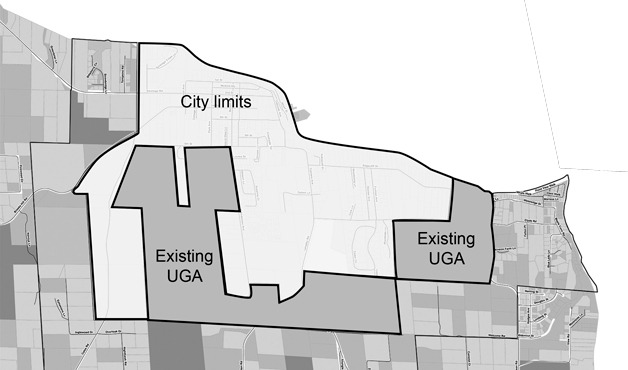Amid discord and disagreement between Langley City Hall and the planning advisory board over how much land was needed for growth, the city council agreed Monday to wait for clarification on several points from county experts before making a decision.
The delay may have worked, as the mayor and city planner said the administration now support a much smaller urban growth area. Director of Community Planning Michael Davolio confirmed that he will offer a revised recommendation to essentially shrink the boundary to city limits, plus a few properties near Coles Road where a sewer line easement exists and connects to the city’s waste water treatment plant. Land lost in the reduced urban growth area will be added to what is called a joint planning area, where the city has a say and is notified by the county when development is occurring.
“I think they’re on board with this,” Davolio said.
At the start of the regular council meeting Sept. 21, the council and mayor amended the agenda and announced no action would be taken on the urban growth area. Council members met the previous week in a workshop with the planning director and planning board, and it became clear then that they would not be able to vote on an option.
Both options presented to the council during the special workshop were to dramatically shrink the area, though the planning board’s option would essentially confine it to city limits.
“Our current UGA is too big,” Davolio said. “The reason it was so big was because we relied on county projections 20-some years ago.”
The urban growth area is part of the process outlined in the Growth Management Act of 1990, landmark legislation designed to keep rural areas rural and urban areas urban. The goal is to limit “urban sprawl” and the loss of agricultural land and forest. About 20 years ago, Langley was projected to have more than 2,000 residents by 2015 and a large urban growth area was approved as a result. The projections proved erroneous, but the city was still facing requirements to provide urban services like sidewalks and sewer lines to those areas.
But Langley never ballooned to that population size, and has about 1,000 residents now. With a projection for only another 89 over the next two decades, Langley’s leaders feel certain they will not need as much area as was planned for in the past. Now it’s a matter of deciding to what degree to shrink Langley’s urban growth area.
The planning director wants to keep more area for some commercial development and to allow for parcels to be developed over the next 20 years to accommodate for possible affordable housing or age-in-place housing. Both of those options would require urban services, such as sewer, for higher density development.
Langley’s planning board, however, says there is space available now within city limits to cover the state and county’s population growth projection of 89 more residents by 2036.
Steve Erickson, co-founder of Whidbey Environmental Action Network, is well versed in the Growth Management Act and urban growth areas in Island County. He warned the city council on Monday that it was too late to question the county’s and state’s population projections methodology, assumptions and market factors. And even if the city did want to object, the decision isn’t theirs.
“The county still has the authority,” he said.
Mayor Fred McCarthy, in a follow-up interview Thursday morning, said he thought the smaller UGA was more appropriate and would allow for the projected growth. His position changed after meeting with the Island County Planning Department and Commissioner Helen Price Johnson on Wednesday. That meeting included some clarifications about the process, McCarthy said.
Gail Fleming, a Langley resident and member of the city’s planning board, urged the council on Monday to read the state’s urban growth area handbook. She, along with other members of the planning board, vehemently opposed Davolio’s original proposal as leaving the county and city open to legal challenge because it essentially ignores the county’s figures.
Though it appears the disagreement has been settled, the city council will still await the results of the next planning advisory board meeting, Oct. 7, before making a decision some time in October.



